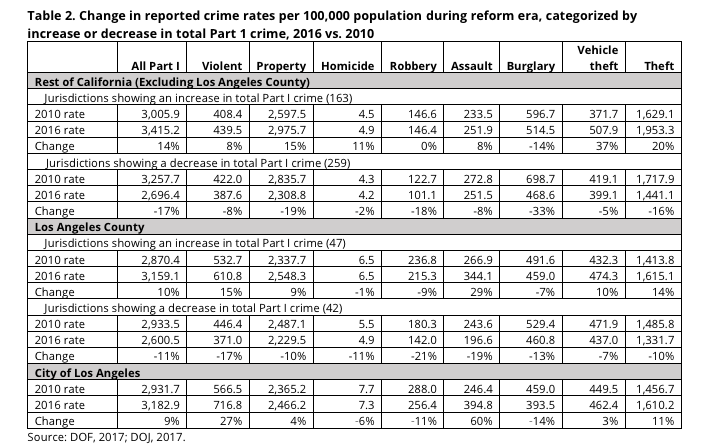Critics of several criminal justice system reforms enacted between 2010 and 2016 in California—namely Public Safety Realignment, Proposition 47, and Proposition 57—have said that the reforms are responsible for rising crime rates.
But property and violent crime rates have varied widely across Los Angeles County (and California) during those years, according to a report by Mike Males, Senior Research Fellow at the Center on Juvenile and Criminal Justice (CJCJ).
In 2011, Public Safety Realignment (AB 109) shifted the incarceration burden for certain low-level offenders away from the California’s state prison system—the largest in the nation until recently—to the state’s 58 counties. The second law accused of increasing crime rates is 2014’s voter-approved Prop. 47, which downgraded six low-level drug and property felonies to misdemeanors. The newest law, Prop. 57, boosts access to early release “good time” credits for eligible inmates who participate in education and other rehabilitative opportunities. Prop. 57 also increases parole eligibility for non-violent offenders who have completed the base sentence for their primary offense. (It also takes the power to transfer kids to adult court out of the hands of prosecutors and gives the control back to judges.)
A proposed ballot initiative, the Reducing Crime and Keeping California Safe Act, aims to reverse some of the criminal justice reforms enacted with the passage of Propositions 47 and 57. The initiative seeks to expand the definition of violent crime, and also impose a third strike for people who steal something worth at least $250. A major point of contention between the tough-on-crime folks behind the initiative and justice reform advocates is whether crime rates are rising or if they are still falling, and whether reforms like Props 47 and 57 have anything to do with crime rates.
The reforms don’t appear to have an effect on crime rates, according to Mike Males.
At the state level, 61 percent (259 of 422) jurisdictions showed decreases in crime rates from 2010 to 2016, according to CJCJ.
At the local level, LA County experienced a 5 percent increase in crime from 2010 to 2016, while crime dropped 5 percent in the rest of the state. Specifically, property crimes rose 4 percent, and violent crimes rose 8 percent in the county, while property crime dropped by 6 percent and violent crime dropped by 2 percent.
Despite the county’s overall rise in crime, nearly half of the county’s jurisdictions reported lower crime rates. Forty-seven percent (41) of LA County’s 89 jurisdictions reported a decrease in crime, while 53 percent (47) saw an increase in crime.
Males says that part of the reason for the difference in crime trends between LA County and the rest of the state is that the city of LA experienced a 60% increase in assaults (although homicide and robbery numbers went down). Males also notes that “the accuracy of the city’s crime reports has been called into question” in recent years.
Beyond the city of Los Angeles, cities like Burbank, Lancaster, Long Beach, and Torrance experienced increases in Part I crimes, while in Downey, Glendale, Inglewood, Monrovia, Palmdale, Pasadena, Pomona, and Santa Clarita, Part I crime numbers dipped.
Crime rates varied greatly between cities. In Artesia, crime rose 112 percent. In Avalon, crime dropped by 52 percent.
And, according to the report, the jurisdictions in which crime rates dropped by 2016, actually had higher average crime rates in 2010 than those jurisdictions that experienced higher crime rates in 2016.
According to Males, this suggests that the jurisdictions that started with higher crime rates implemented successful policies and practices that helped to reduce crime.
This week’s report, in addition to another recent CJCJ report, which pointed to variations in property crime statewide, show that crime trends are “highly localized,” according to CJCJ, and not the result of statewide legislative reforms like Props 47 and 57, and AB 109.


Where’s the numbers comparing the “release areas” to the crime rates?
WLA, do you think you guys could ever do a comprehensive article?
Looks like Taylor went with the “baffle with bullshit” technique on this one, what a mess.
LOl….It does seem like a half hearted attempt at reporting on a rather important topic. At least WLA say can argue they do in fact present fair, balanced and unbiased reporting….NOT.
Check out the CJCJ website. That’ll explain everything.
Rapes, robberies, and aggravated assaults all increased nationwide in 2016, according to the FBI. The bureau reported 17,250 homicides in the United States last year, an increase of nearly 9 percent from 2015.
Everyone wants criminal justice reform, they all talk about it. Nobody talks about reforming the bad guys until they get to the joint when it’s too late. Nationwide they keep finding ways to let these thugs out early or give them less and less time to do and they victimize more and more innocents that people at WLA care not one bit about.
Your answer to lower crime rates is in the third paragraph; Changed classification of six felonies to misdemeanors. So of course the violent crime will go down. Hey why didn’t you write about the drop in violent domestic violence since those are now classified as a “non-violent” felony?
Don’t look behind the curtain.
Liberals don’t want to find the truth. It goes against their narrative.